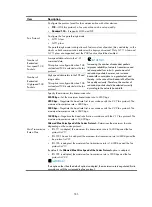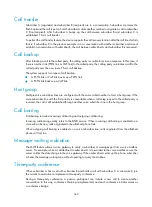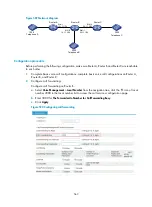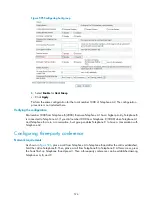
562
•
O if the terminating PBX fails to obtain the calling number (for example, the originating PBX end
does not send it)
A message in the MDMF contains the following information:
•
Date and time when the voice call occurs (MM DD hh:mm)
•
Calling number and calling name if CID is enabled on the device
•
Two Ps for the calling number and the calling name, respectively, if CID is disabled on the device
•
O if the terminating PBX fails to obtain the calling number (for example, the originating PBX end
does not send it)
•
O if the terminating PBX fails to obtain the calling name (for example, the originating PBX end does
not send it)
The FXS voice subscriber line sends the calling identity information to the called telephone. The calling
identity information is sent to the called telephone through FSK) modulation between first and second
rings. Therefore, the called user must pick up the telephone after the second ring to be sure that the
calling identity information is sent and received correctly. Otherwise, the calling identity information
might fail to be displayed.
CID on the FXO voice subscriber line
The FXO voice subscriber line receives the calling identity information from the PBX. The FXO interface
receives the modulation information of the calling identity information from the PBX between the first and
second rings. This is the default situation. You can configure the
Time for CID Check
on the FXO line
configuration page to configure the time for CID check.
The calling identity information then undergoes FSK demodulation and parity check. The function of
sending calling identity information is checked after the parity check succeeds. If the function is enabled,
the calling identity information (indicating that the calling identity information is received) is sent.
Otherwise, the character
P
or
O
is sent.
Support for SIP voice service of the VCX
Together with a server, the VCX implements the application of multiple voice features such as Silent
Monitor, Camp On, and FwdMail Toggle by using the HP proprietary SIP Feature messages.
Configuring call services of a local number
Configuring call forwarding, call waiting, call hold, call
transfer, and three-party conference
Select
Voice Management
>
Local Number
from the navigation tree, and then click the icon of the
local number to be configured to access the call services configuration page as shown in
.
Summary of Contents for MSR SERIES
Page 17: ...xv Documents 835 Websites 835 Conventions 836 Index 838 ...
Page 20: ...3 Figure 3 Initial page of the Web interface ...
Page 42: ...25 Figure 13 Firefox Web browser setting ...
Page 59: ...42 Figure 27 Checking the basic service configuration ...
Page 73: ...56 Figure 35 Sample interface statistics ...
Page 156: ...139 Figure 139 Rebooting the 3G modem ...
Page 168: ...151 Figure 152 Configuring Web server 2 ...
Page 174: ...157 Figure 158 Configure the URL filtering function ...
Page 242: ...225 Figure 233 Enabling the DHCP client on interface Ethernet 0 1 ...
Page 247: ...230 Figure 236 The page for configuring an advanced IPv4 ACL ...
Page 255: ...238 Figure 241 Advanced limit setting ...
Page 298: ...281 e Click Apply 2 Configure Router B in the same way Router A is configured ...
Page 400: ...383 Figure 387 Verifying the configuration ...
Page 405: ...388 ...
Page 523: ...506 Figure 530 Ping configuration page ...
Page 775: ...758 Figure 785 Configuring a jump node ...






























